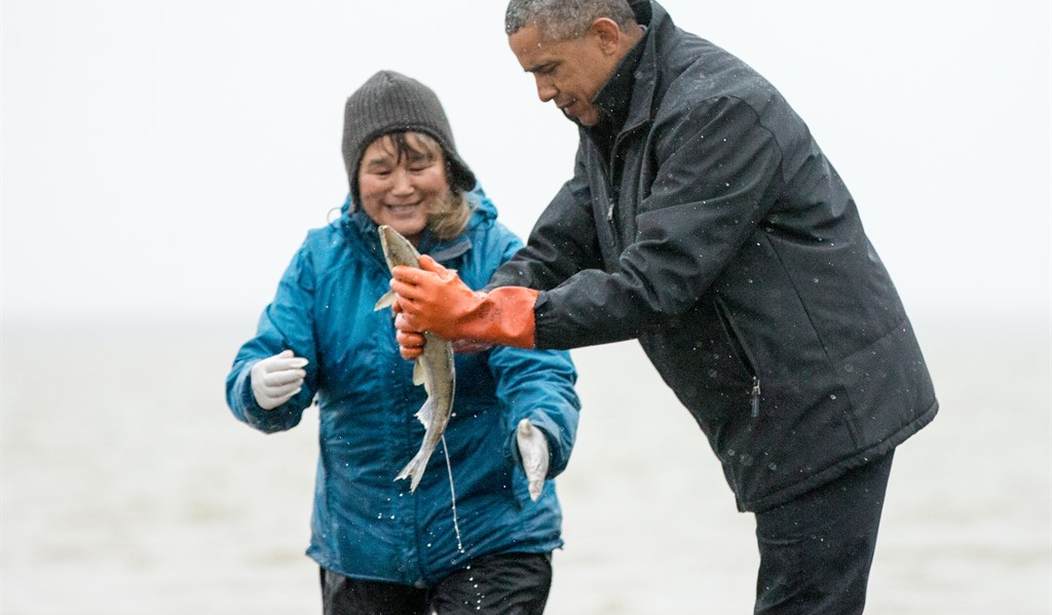Obama’s trip to Alaska is over, but his crusade to save us from global warming continues. The president recently concluded a three-day trip to Alaska, which began on August 31:
One thing I’ve learned so far is that a lot of these conversations begin with climate change. And that’s because Alaskans are already living with its effects. More frequent and extensive wildfires. Bigger storm surges as sea ice melts faster. Some of the swiftest shoreline erosion in the world – in some places, more than three feet a year.Alaska’s glaciers are melting faster too, threatening tourism and adding to rising seas. And if we do nothing, Alaskan temperatures are projected to rise between six and twelve degrees by the end of the century, changing all sorts of industries forever.
This is all real. This is happening to our fellow Americans right now. In fact, Alaska’s governor recently told me that four villages are in “imminent danger” and have to be relocated. Already, rising sea levels are beginning to swallow one island community.
Think about that. If another country threatened to wipe out an American town, we’d do everything in our power to protect ourselves. Climate change poses the same threat, right now.
The president took photos of his trip and posted them on the White House’s website. He visited the receding Exit Glacier saying it was “as good a signpost of Climate Change as anything." The problem is that the glacier has been receding since 1815, according to the National Park Service. Moreover, the Hubbard Glacier has been growing since 1978. This point was highlighted in former Alaskan Gov. Sarah Palin's post on IJReview about the president's trip. Concerning the United Kingdom’s Meteorological Office, global temperatures have stagnated for almost two decades. The Times called the trip “minutely choreographed.”
Recommended
Four times in a 24-minute speech in Anchorage he declared that “we’re not acting fast enough,” a message especially true in the countdown to December’s United Nations climate conference in Paris. This will be the most ambitious effort by the world’s nations to produce an equitable deal on reducing greenhouse gases, and the United States, as the world’s second-largest emitter of carbon gases (after China), must be at the forefront of the effort.Alaska is the president’s last stop on a late-summer climate change tour designed to enhance his record on the issue as well as America’s leadership position and its leverage at the Paris talks. At a conference in Las Vegas, he threw his weight behind the solar energy industry and unveiled initiatives aimed at increasing energy efficiency. In New Orleans, on the 10th anniversary of Hurricane Katrina, he spoke of the need to make coastal cities more resilient as they face the rising seas and stronger storms that a warming planet is likely to bring.
Prior to leaving for Alaska, the administration renamed Mt. McKinley, the tallest mountain in North America, to Denali. It was done as part of the Obama administration’s ongoing Native American outreach, according to The New York Times.
Besides discussing our pending doom from global warming, the president also snapped some selfies with survivalist and former British Special Air Service reservist Bear Grylls, where he’s expected to make an appearance on the new show Running Wild With Bear Grylls. It’s scheduled to air on NBC later this year:
…it is rumored that the president’s office made the approach to Grylls, rather than the other way round, as part of a broader strategy for Obama to reach out to potential voters turned off by conventional political debate.Last Tuesday [Sept. 2] the two hiked along the Exit Glacier, a south Alaskan river of ice that has shrunk by 1.25 miles in recent decades. There was no extreme skydiving or abseiling. The results, according to the White House press secretary Josh Earnest, promise to be “interesting”.
Still, while global warming might animate some within the Obama coalition and the larger Democratic base, most don’t see it as a serious threat, according to Gallup. That’s not to say that they don’t believe this natural phenomena is happening–they do. They just don’t seem to care–and given how this president dredges up partisan feelings whenever he speaks about the issues; we shouldn’t expect the needle to move in either direction on this one. Most Americans are more concerned about jobs, the economy, and the direction of the country. Not glaciers that have been melting since 1815.


























Join the conversation as a VIP Member